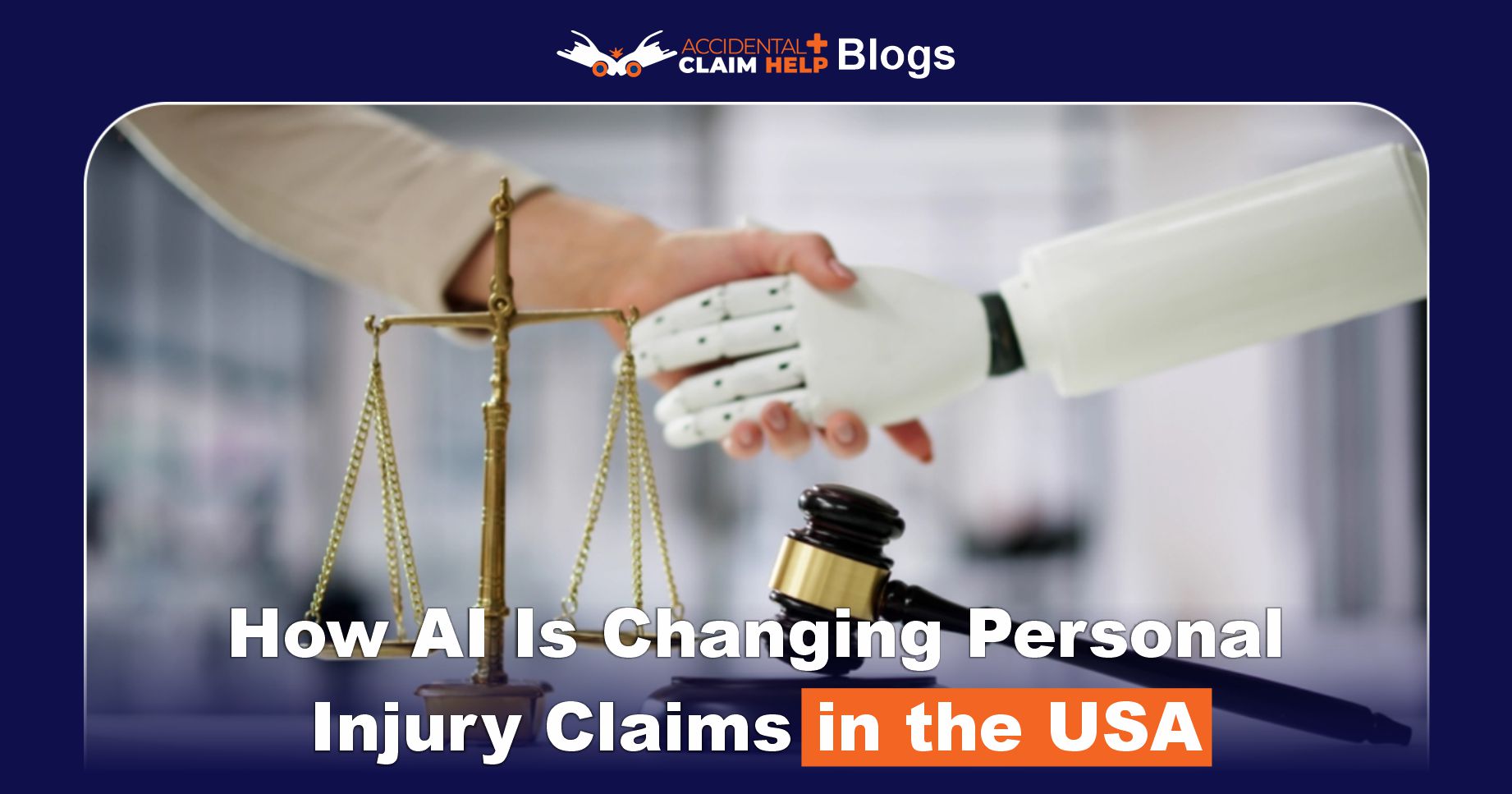How AI Is Changing Personal Injury Claims in the USA
Artificial intelligence (AI) is rapidly transforming how personal injury claims are handled in the United States. Insurers now use AI-driven algorithms to process claims more quickly and cost-effectively. These systems can analyze medical records, police reports, and repair estimates to predict settlement ranges, evaluate damages, and even decide whether a case is likely to settle or go to court. The result is a claims process that can be much faster, but also more opaque. Injured claimants may receive automated offers generated by algorithms they’ll never see, raising questions about fairness and accuracy.
How Insurers Use AI to Evaluate Claims
Insurance companies are increasingly adopting AI and machine learning to review personal injury claims at scale. For example, many insurers now use AI software to scan medical and accident reports immediately upon claim submission. The AI “reads” medical records and extracts data on treatment, then compares this information with databases of past claims. Algorithms predict potential medical costs, lost wages, and a likely payout range based on historical outcomes. In practice, this means a new auto accident claim may be processed by software hours after it’s filed – long before a human adjuster looks at the file.
Insurers also use AI for fraud detection and risk assessment. Pattern-recognition algorithms flag unusual claims for extra review. For instance, if a claimant’s treatment pattern or social media posts differ markedly from the norm, the AI may classify the case as “high-risk.” This helps carriers identify potentially inflated or false injury claims. Other AI tools handle routine communication: chatbots or claims portals can collect information from claimants and even schedule inspections or medical exams without human staff. All of these AI-driven steps aim to streamline operations – insurers handle more claims with fewer adjusters, reducing overhead.
- Injury assessment: AI algorithms evaluate the severity of injuries by extracting data from medical reports and claim forms.
- Settlement estimation: AI compares new claims to historical data to estimate a “reasonable” payout range.
- Predictive analytics: Some systems predict whether an insured will accept a settlement or litigate.
- Automated triage: Claims are classified by severity and completeness. Missing or inconsistent data are auto-flagged.
- Fraud screening: Unusual patterns in treatment or billing trigger alerts for human review.
- Settlement guidance: AI may suggest quick offers for minor claims and reserve deeper review for serious injuries.
These AI processes occur with little to no human review. Insurers benefit through faster decisions and lower costs, but claimants must be aware that a computer, not a person, may be making early judgments about their case.
Faster Processing and Automated Settlement
The use of AI means many aspects of a claim are automated. From the moment an accident occurs, AI systems can spring into action. For example, after a car crash, a claimant might submit photos and police reports through an app. AI tools can immediately analyze these inputs: digitizing photos of damage, reconstructing crash details, and estimating repair costs within minutes. Similarly, if an injury claim involves medical bills, the system can quickly total those costs and cross-check for errors or duplicate charges. This immediate analysis helps insurers make early liability and settlement decisions long before a human review.
One major change is automated settlement offers. By analyzing all claim data against a vast history of similar cases, AI can propose a settlement amount without waiting for an adjuster. In practice, this often means injured parties receive a quick offer, sometimes very early in the process. For low-value claims – such as minor whiplash injuries – the AI might recommend a rapid payout to save resources. While this can be convenient for straightforward cases, it also risks shortchanging claimants whose needs are more complex. The quick offer may not account for long-term medical care or pain and suffering, forcing victims to accept a low “take-it-or-leave-it” amount if they lack guidance.
The upside is improved efficiency. According to industry reports, insurers using AI claim to cut settlement times by up to 35–40% and significantly boost customer satisfaction. Faster resolutions mean insurers face less legal exposure, and carriers can offer more immediate service (for example, virtual assistants updating policyholders). In 2025 it is estimated that the vast majority of large carriers will have implemented some form of AI for claims processing. Top companies like Nationwide and Liberty Mutual explicitly advertise AI tools for faster claim support.
Concerns: Bias, Undervaluation, and Errors
While AI brings efficiency, it also brings concerns about fairness and accuracy. Critics worry that algorithms may undervalue certain claims or make mistakes that a human adjuster would not. One major issue is undervaluing intangible losses. AI is good at calculating concrete costs (medical bills, lost wages) but struggles with subjective factors like pain and suffering or emotional distress. Because algorithms can’t truly measure how an injury affects a person’s life, they often assign low values to these losses. Lawyers caution that AI might reduce “complex human experience into a data point,” ignoring trauma and long-term effects.
Bias is another problem. AI learns from historical data, which may contain the insurance industry’s past prejudices. For instance, if a carrier traditionally paid lower settlements to claimants from certain neighborhoods or economic groups, the AI might perpetuate that trend unknowingly. Plaintiffs fear that algorithmic decisions could continue outdated patterns of discrimination under the guise of neutrality. Because claim decision processes are opaque, claimants cannot easily challenge an offer they suspect is biased. Unlike a human adjuster, an AI won’t explain why it “flagged” a claim as low value.
Real-world examples highlight these risks. In California, a class-action lawsuit alleged that one insurer’s AI system systematically underpaid claims for soft-tissue injuries without individualized review. Another case accused an AI tool of wrongly denying hundreds of thousands of benefit claims by ignoring doctors’ decisions. These lawsuits show that AI errors aren’t just theoretical – they can materially harm injured people. Regulators are taking notice: some states are considering laws to ban fully automated claim denials and require human review of any AI-decided claim.
In summary, AI-driven claim decisions can go wrong in several ways:
- Undervaluation: Offers may be far too low on pain, suffering, or long-term care because AI can’t weigh them properly.
- Discrimination: AI trained on biased data can reproduce unfair settlement patterns against minorities or low-income claimants.
- Opaque decisions: Automated systems don’t provide reasoning, making it hard to dispute a low valuation.
- Mistakes: Data entry errors or misinterpretation by AI can lead to wrongful claim denials or reduced payouts.
The Attorney’s Perspective and Legal Tech
Personal injury lawyers are adapting to this AI-driven landscape. They often use technology themselves to keep up. Many firms now employ legal research tools powered by AI to sift through thousands of cases, statutes, and medical records in seconds. For example, an attorney handling a car accident case can use AI databases to find recent jury verdicts in similar wrecks and better gauge what a “fair” settlement might be. AI also helps with administrative tasks: document management systems can organize all of a case’s medical bills, police reports, and witness statements automatically, saving staff hours of manual work.
The net effect is that tech-savvy lawyers can level the playing field. AI in law firms enables attorneys to manage larger caseloads more efficiently and prepare stronger cases. Firms that use AI tools demonstrate a commitment to innovation and often market this advantage to clients. However, attorneys emphasize that human judgment remains essential. AI is a tool, not a replacement for an advocate’s experience. Lawyers still review every case and can challenge AI-driven decisions – for example, by requesting information on how an insurer’s algorithm works or consulting expert witnesses if an AI seems to have “undervalued” a client’s injury.
Because of AI’s role, the attorney’s job now often includes educating clients about technology. Lawyers advise clients to document everything. Complete medical records, detailed expense reports, and clear evidence of ongoing symptoms help prevent an AI from missing key facts. Attorneys also counsel caution about accepting quick offers. If the AI suggests a fast settlement, a lawyer will check whether it truly covers all future treatment and losses. In practice, an attorney might use AI-driven analytics to value a claim and then negotiate or litigate if the insurer’s automated offer is too low.
In other words, AI is changing not just insurers but also legal practice. Clients benefit when attorneys harness technology to build stronger cases, and they are protected when lawyers scrutinize and question the AI’s work on the insurance side.
Protecting Your Claim in an AI-Driven System
For an injured person, the rise of AI in claims means it’s more important than ever to take control of your evidence and choose good representation. Keep in mind:
Provide thorough documentation. AI systems rely on data points. Missing or incomplete information (like gaps in medical records or unclear reports) can cause an algorithm to downplay an injury. By giving the insurer’s system full information – complete medical files, itemized bills, physician statements on prognosis, and detailed lost-wage summaries – you ensure the AI has all the data it needs. This reduces the chance of undervaluation and supports a higher, more accurate settlement offer.
Be wary of quick settlement offers. If the insurer sends an early “take-it-or-leave-it” offer, consider it carefully. AI often classifies cases by “typical” value and may push for fast payouts on what it deems low-severity cases. Serious injuries can take years of treatment and have future costs. Always have an attorney review any automated offer to make sure it covers your full recovery, not just immediate bills.
Ask questions about AI use. You can request (through your lawyer) to know if an AI was used in evaluating your claim. Some states are pushing for rules requiring disclosure when AI tools are involved. If you suspect bias or error (for example, if claims from your area or demographic group seem consistently low), raising the issue early can prompt closer human review.
Consult an experienced attorney. A lawyer who understands AI in insurance can proactively counter automated tactics. They will ensure all relevant factors (like pain and suffering, long-term disability, emotional trauma) are presented, even if an algorithm overlooks them. The attorney can also use their own AI-powered resources (legal research, analytics) to support your claim. Their role is to combine technological tools with personal advocacy.
AI is here to stay in the insurance industry. By staying informed and working with a skilled attorney, injured victims can protect their rights and pursue full compensation, despite the shift toward automation.
Conclusion
Artificial intelligence is already reshaping personal injury claims in the U.S. Insurance companies use AI to evaluate injuries, streamline processing, and even automate settlements. This brings faster decisions and cost savings for insurers, but also new challenges for claimants. Key losses like pain and suffering may be undervalued, and hidden biases in the data can skew outcomes. As a result, legal experts stress the importance of human oversight: thorough documentation, skeptical review of AI-driven offers, and aggressive use of attorneys to advocate for fair value.
In this evolving landscape, remaining informed is crucial. Courts and regulators are beginning to catch up with AI’s role in claims, and lawsuits are forcing greater transparency. For now, anyone filing a personal injury claim should assume a computer will touch their case and prepare accordingly. By combining data (complete records and evidence) with legal support, claimants can navigate an AI-augmented system and work toward just compensation. In short, AI is changing how personal injury claims are handled — and understanding that change is essential to protecting your rights.







